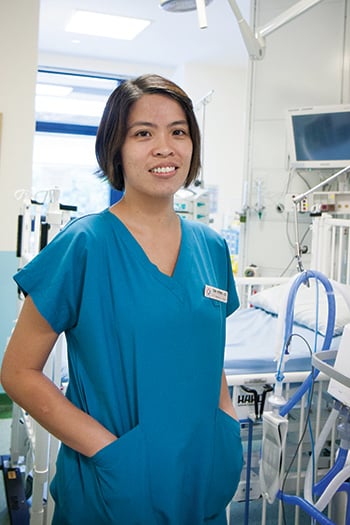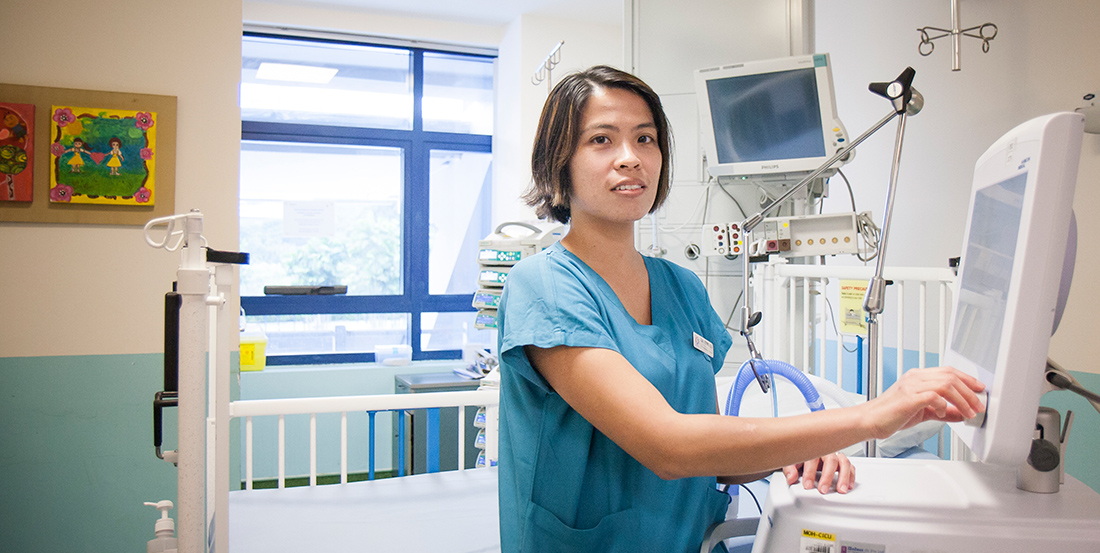W hen respiratory and airway conditions affect the breathing of patients, respiratory therapists provide care through the use of sophisticated breathing machines and by giving sound advice to ease their patients’ suffering. They work mainly in the Intensive Care Unit (ICU) with nurses, doctors and other health professionals to improve the clinical status of patients.
But nobody would explain the role of a Respiratory Therapist better than Respiratory Therapists themselves. Tan Herng Lee did this perfectly – she walks us through her responsibilities as Senior Principal Respiratory Therapist at KK Women’s and Children’s Hospital, a hospital under the Singapore Health Services (SingHealth). Having been a Respiratory Therapist for over 13 years, Herng Lee has much to share about the ups and downs of a career in this specialised field. Herng Lee tells us more.
Give us a better understanding of what you do as a Respiratory Therapist.
Tan Herng Lee: In the ICU, we see critically ill patients being attached to numerous machines and with different tubes inserted into them. Our job is to help them breathe via the manipulation of parameters on breathing machines, which we term mechanical ventilators. There are various types of mechanical ventilators – some are more sophisticated, complex and offer a wider range of support, while others are simpler and offer just a touch of support. As Respiratory Therapists, we need to know which type of machine to use for different patients and the parameters at which to set them.
One of the challenges of being in a paediatric ICU is that, unlike in an adult ICU where the range of patients’ parameters (e.g. blood pressure, breathing rate) can usually be generalised across the adult population, these parameters for children are dependent upon their age and weight. Furthermore, paediatric patients include infants who are unable to communicate their discomfort. This means we have to rely a lot more on patient assessment in order to do our job well, which requires us to understand their well-being and conditions.
What is fulfilling about your job?
Herng Lee: It is in knowing that my contributions – be it through adjusting the mechanical ventilator settings, or suggesting alternative therapy based on evidence-based up-to-date studies – will impact the course of patients’ health, and allow them to recover faster and with minimal complications.

Tan Herng Lee
Healthcare Scholar
Senior Principal Respiratory Therapist, KK Women’s and Children’s Hospital
Apart from being well-versed in clinical skills and knowledge in this highly-specialised field, we are also required to be familiar with the function of our machines and to troubleshoot when issues arise. This is in order to ensure minimal downtime and that patients are not affected. It is fulfilling to know that our knowledge and technical expertise contribute to safer and better outcomes for patients.
Are there any memorable episodes you’d like to share?
Herng Lee: I once had a patient in her 20s who underwent complex surgeries and multiple therapies as a result of muscle weakness and abnormal heart rhythm. While she managed to pull through, we had difficulty getting her off the ventilator due to her weakened condition. I tried to convince her to undergo a surgical procedure called a tracheostomy, which required an insertion to be made in the windpipe to insert an artificial air passage for breathing. This was recommended because being connected to a ventilator for a long period increases the risk of infection, which then leads to worsening condition, prolonged dependence on the breathing machine, and prolonged time in the ICU.
However, having already gone through numerous surgeries, she was initially uncertain about the tracheostomy procedure due to her fear of undergoing any further surgical intervention. It took a lot of explaining for her to understand why the benefits outweigh the disadvantages. She understood, went for the procedure and got off the breathing machine eventually with a lot of support from us. What touched me was that she recognised me in hospital sometime after her discharge, approached me and thanked me for what I’ve done. It was heartwarming to see her recover completely.

Why should aspiring healthcare scholars consider a career in Respiratory Therapy?
Herng Lee: Respiratory Therapy is a fairly young profession in Singapore as compared to the other allied health professions. We are concentrated mainly in the ICU, utilising our expertise in respiratory care to optimise patient safety and outcomes. Aspiring healthcare scholars should consider a career in Respiratory Therapy if they are passionate about providing care, and want to help critically ill patients breathe better.
What advice would you give to those who wish to become a Respiratory Therapist?
Herng Lee: Respiratory therapists need to be able to think on their feet and respond well in emergencies. In the ICU, patients’ conditions can change rapidly and any delay might have a negative impact on patients’ outcomes. They should also be mentally strong so as to cope with emotionally challenging situations such as patients’ death.
Aspiring healthcare scholars who seek to develop themselves in the field of respiratory care and who want to contribute meaningfully to patients who are critically ill would definitely be a good fit for the job.

